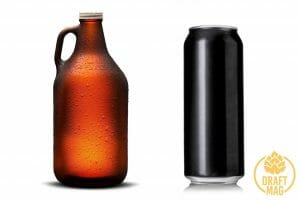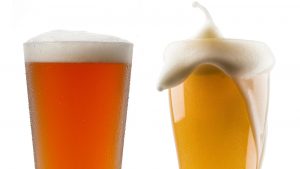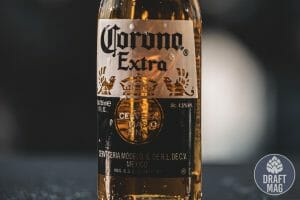Bud Light vs Budweiser: The Differences and Similarities
Bud Light vs Budweiser is one of the most hotly debated topics among zythophiles, and it’s not hard to see why — they’re both great!
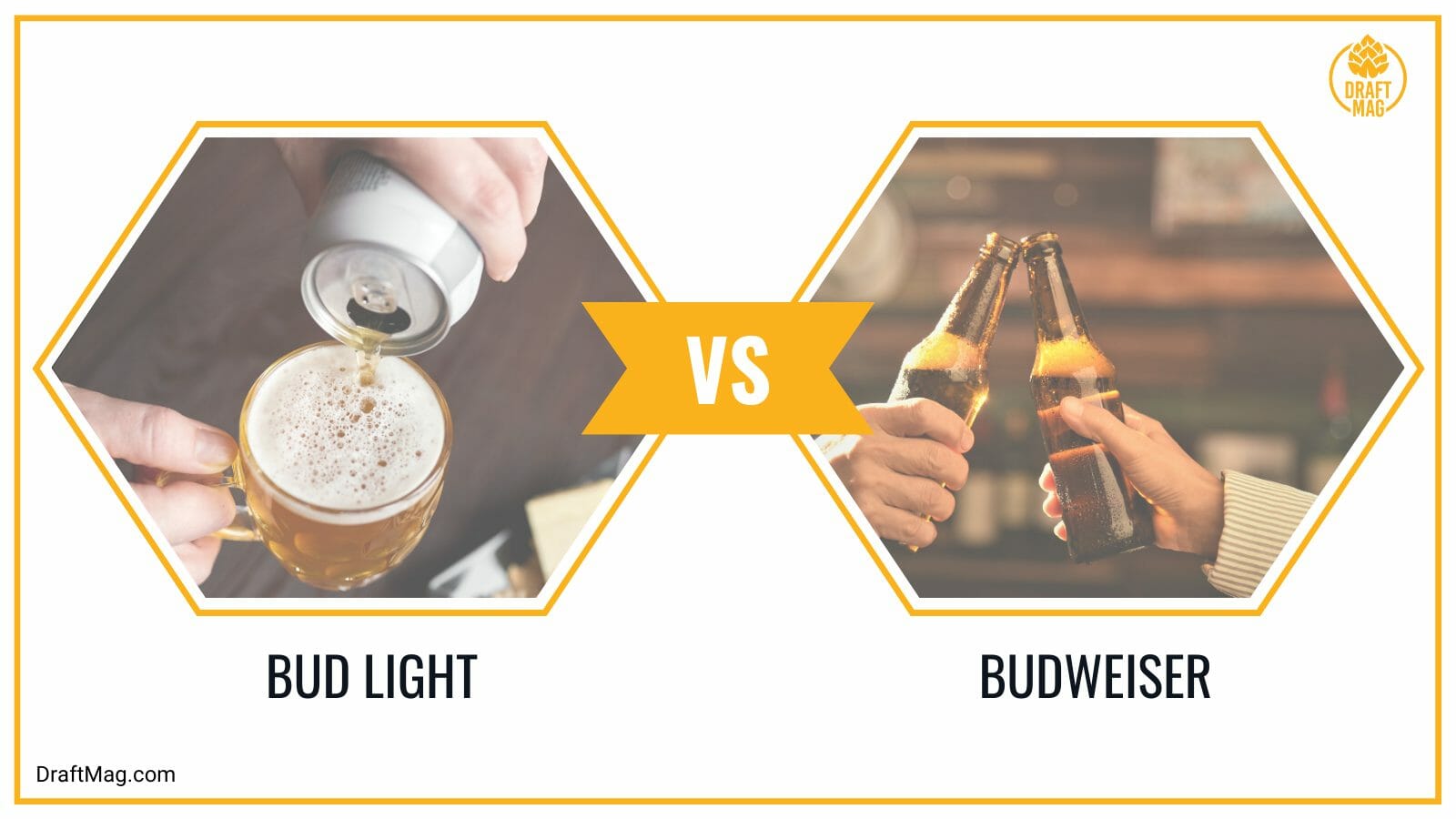
However, questions still arise about their individual characteristics and how they differ.
In this article, we will examine the differences between both beers, and also consider what each beer is best for. Let’s get into it!
Bud Light vs Budweiser Comparison Table
Below is a table that compares Bud Light and Budweiser, overviewing their differences and similarities.
| Features | Bud Light | Budweiser |
| Style | American-style light lager | American-style pale lager |
| Taste profile | Refreshing, crisp finish with delicate malt sweetness | Crisp, clean finish with subtle malt flavors and fruity notes |
| Alcohol content (ABV – alcohol by volume) | 4.2 percent | 5 percent |
| Color | Golden straw | Golden |
| Ingredients | Water, barley malt, rice, hops, yeast | Water, barley malt, rice, hops, yeast |
| Calories per serving | 110 | 145 |
| Carbs per serving | 6.6 grams | 10.6 grams |
| Protein per serving | 0.9 grams | 1.3 grams |
Feel free to take a look at our informative article about Bud Light’s alcohol content, including its various versions.
What Are the Differences Between Bud Light and Budweiser
The main difference between Bud Light and Budweiser is Bud Light has fewer calories, carbs, and proteins than Budweiser. Moreover, Bud Light has a lesser alcohol content than Budweiser. Bud Light also has a lighter mouth feel, with a delicate malt sweetness compared to Budweiser’s fruity notes.
What Is Bud Light Best For?
Bud Light is best for hot-weather consumption and low-intensity dishes. This is because of its refreshing taste and relatively high carbonation.
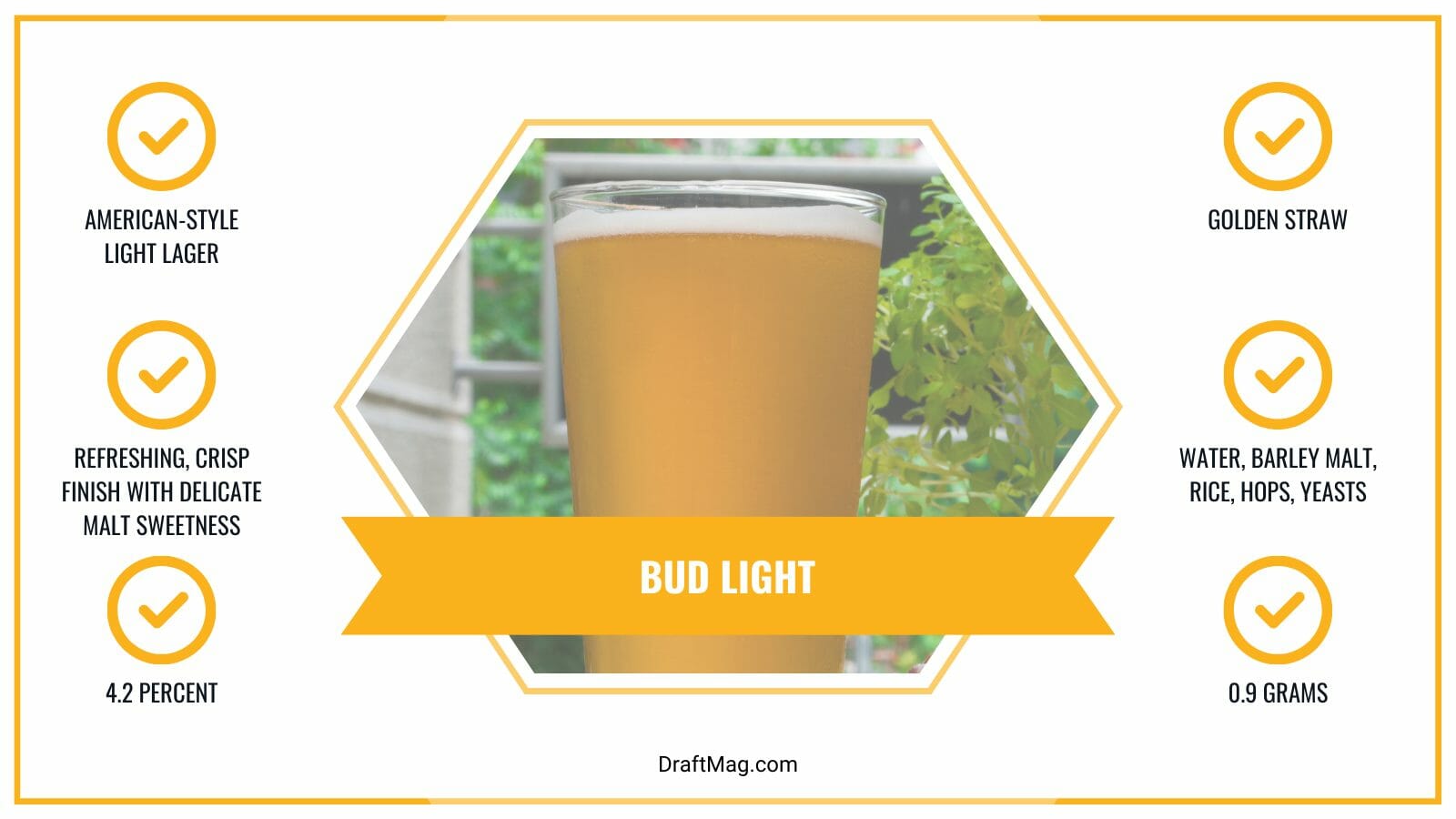
This beer is also perfect for people who want to enjoy beer but cannot tolerate the intense flavor of traditional beer.
Below are some of the characteristics of Bud Light that helped us formulate this answer.
– Mouth Feel
Bud Light has a light, crispy, and refreshing feel with the delicate sweetness of the malt. These properties are the reason why the mentioned beer is popular among younger drinkers.
The refreshing feel of the beer makes it ideal for warm weather conditions. Bud Light also has a very subtle fruity aroma, further endearing the younger target audience. While the beer is sweeter than a traditional beer, it is not overly sweet, and still very much retains beer’s unique bitterness.
The mouth feel of a beer goes a long way in determining its target audience. Younger drinkers usually prefer beers with a lighter, sweeter, and more refreshing feel.
– Bud Light Alcohol Content
Bud Light has an alcohol content of 4.2 percent ABV. This falls within the typical range for beers (4-7 percent). The alcohol content of a beer is measured in alcohol by volume, which is simply the amount of pure alcohol that beer contains.
– Ingredients
Bud Light’s ingredients are water, barley malt, rice, hops, and yeast. These are the basic ingredients of traditional beers. However, what sets Bud Light apart is how many ingredients it uses.
Bud Light uses lesser amounts of barley malt and rice than traditional beers. Unsurprisingly, this confers a lighter feel to the beer.
– Nutritional Value
The three components we will examine are calories, proteins, and carbs. Bud Light calories count is 110. Also, a 12-ounce serving of beer contains 6.6 grams of carbs and 0.9 grams of protein. There is no fat in this beer. All of the nutritional values of this beer are lower than traditional beer, which further justifies its ”light” nomenclature.
An important feature of a beer is its nutritional value. In fact, this is the tie-breaker for many people when choosing between two similarly good beers.
– Appearance and Aroma
Bud Light has a golden straw color and is typically clear upon viewing from a glass cup. When poured, a white froth appears but does not persist for long.
This beer has a delicate malt and fruity aroma. It can be perceived as grainy and slightly sweet. Additionally, Bud Light uses premium aroma hop types, which contribute to the special aroma and bitterness of this beer.
What Is Budweiser Best For?
Budweiser is best for flavorful and high-intensity dishes. This beer is ideal for fans of traditional beer and its aroma, flavor, and mouth feel.
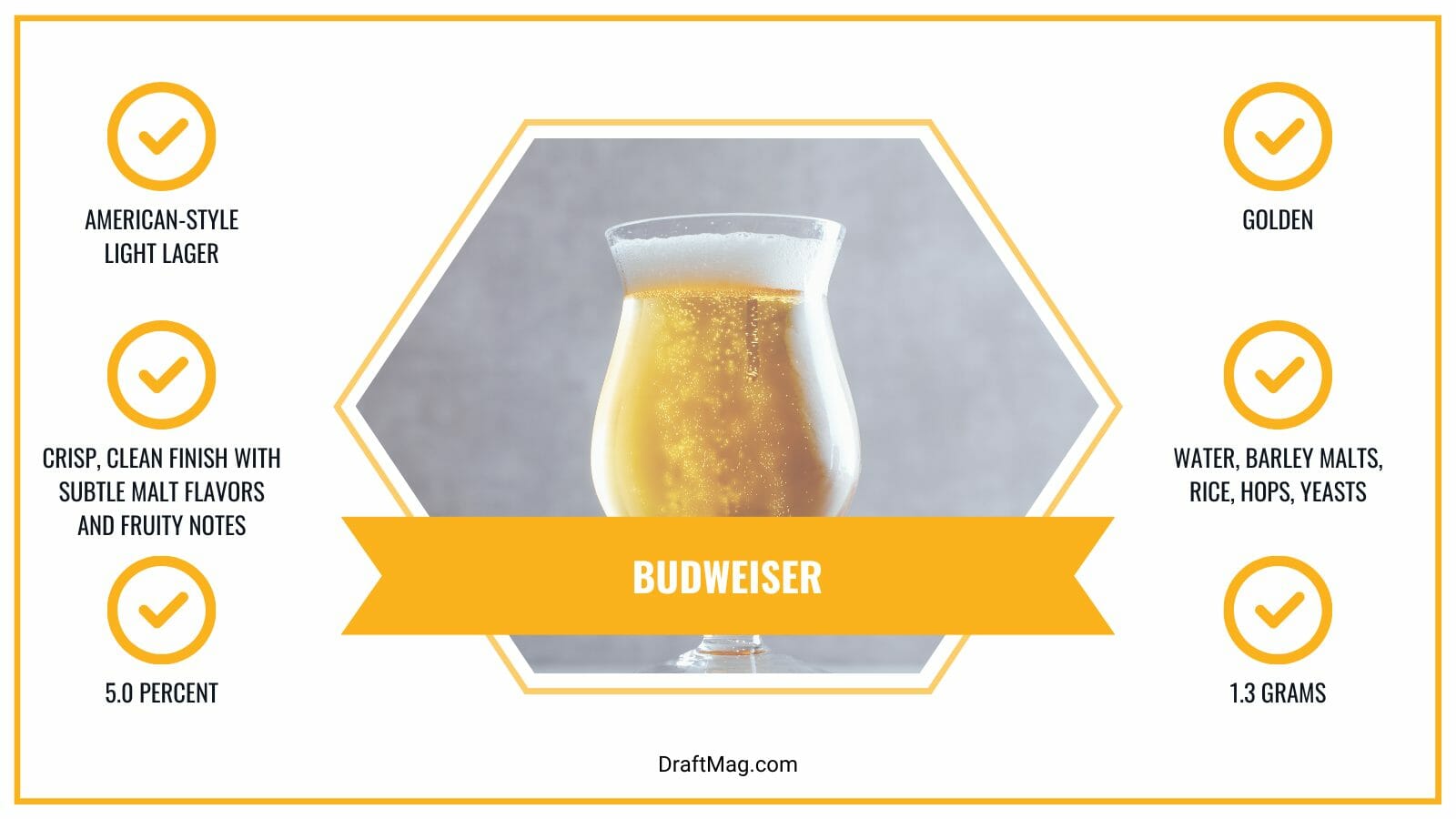
Considering its heavy nature, this drink is ideal for people that want a fulfilling drinking experience.
Let us examine some of the features of Budweiser that led us to this recommendation.
– Mouth Feel
Budweiser has a crisp and dry finish with a grainy fruity flavor. This beer also has a dry palate. These properties are similar to traditional beers, making Budweiser more popular among older drinkers.
The hop bitterness is low, which is why many perceive this beer as sweet. Its crisp-and-dry finish is well masked by its high carbonation levels.
– Budweiser Alcohol Content
Budweiser has an alcohol content of 5 percent ABV. This is the alcohol content of most traditional beers. The alcohol content of a beer is measured in alcohol by volume, which is the amount of pure alcohol that beer contains.
– Ingredients
Budweiser’s ingredients are water, barley malt, rice, hops, and yeast. Compared to its lighter counterparts, Budweiser uses higher amounts of barley malt and rice.
The Budweiser formula usually uses two- or six-row barley with a high percentage (up to 40%) of rice as adjuncts. Brew-masters may adjust this formula depending on the type and quality of grains available.
Budweiser uses special German hops, like SaaZ and Hallertau. If these hops are not readily available, brewers use other European hops.
– Nutritional Value
The three nutritional components we will consider are carbs, proteins, and calories. There is no fat in Budweiser.
One 12-ounce serving of Budweiser contains 145 calories, 10.6 grams of carbs, and 1.3 grams of protein. All of these values are higher than light lager beers, like Bud Light, Coors Light and Miller Lite.
– Appearance and Aroma
Budweiser has a golden color. When poured, a white frothy head appears but does not persist for long.
This beer has a subtle malt aroma, with a light apple character. Aside from the apple fruitiness note, Budweiser has a slight honey and citrus scent.
Frequently Asked Questions
– Is Bud Light More Popular Than Budweiser?
Yes, Bud Light is more popular than Budweiser. Light lagers are typically more popular than their heavier counterparts. This is a trend that other common light lagers, like Busch Light and Corona Extra, follow.
– Why Is Bud Light More Popular Than Budweiser?
The most reasonable explanation is that people prefer sweeter and more refreshing beers to heavier traditional beers. Bud Light is lighter in every area than Budweiser. As you can see from the table above, it has fewer calories, proteins, carbs, and alcohol content.
Another plausible explanation is the nutritional value and alcohol content of the two beers. People tend to prefer drinks with lower calories and alcohol content for everyday use.
In some regions outside the United States, particularly around Germany and Britain, heavier and more traditional beers are preferred. Therefore, Budweiser will be more popular in such regions.
– Bud Light vs Budweiser: How Do The Sales Compare?
In terms of sales in the United States, Bud Light is in a class of its own. Let’s put that in context.
According to estimates, Anheuser-Busch InBev brewing company shipped 27.2 million barrels of the beer in 2019.
The next two closest challengers – Coors Light and Miller Lite – shipped around 26.4 million barrels of beer that same year. Ridiculous is the word you’re looking for!
Budweiser comes in at a very respectable fourth place, with Anheuser-Busch InBev shipping 10.6 million barrels of the beer in 2019. Rounding up the top five is Michelob Ultra with 10.2 million barrels.
The number of sales of both beers just reinforces the difference in popularity of light and standard American lagers.
– Which Is Healthier Between Bud Light and Budweiser?
One of the most interesting areas of the beers – Bud light vs Budweiser: Nutrition. Bud Light is lighter in all nutritional components than Budweiser. Of all the nutritional components usually examined – calories, fat, protein, and carbs – Bud Light vs Budweiser calories are the most related to healthiness.
Since Bud Light has a lower calorie count (110) than its heavier counterpart (145), it is usually perceived as healthier. Budweiser’s case is also not helped by its higher alcohol content, albeit a small difference. The consensus is higher alcoholic drinks are more exerting on the liver and, by implication, less healthy.
Considering all of these, Bud Light can be said to be healthier than Budweiser.
– Is Bud Light Stronger Than Budweiser?
The strength of an alcoholic drink is measured by its alcohol content. Therefore, Bud Light vs Budweiser alcohol content will answer this question.
Budweiser has a 5 percent ABV, compared to Bud Light’s 4.2 percent. By implication, Budweiser is the stronger of the two beers. However, the difference is practically unnoticeable when both the drinks are taken in moderation.
– Are There Similarities Between Budweiser and Bud Light?
Yes, absolutely!
While the two beers are different in their fundamental styles, they share some similarities. For one, they use the same basic ingredients, although in slightly different proportions. Also, they are both golden in color, and it will be very tricky to identify them when poured into transparent cups.
Another important similarity is in the aspect of their nutritional value, as they both contain 0 grams of fat. Additionally, both beers are types of craft beer and manufactured by the same brewing company – Anheuser-Busch InBev.
– Is Bud Light Platinum Similar to Budweiser?
The light platinum version of Bud Light is closer to Budweiser than Bud light itself. Although this version is still a light lager, like its parent, it is denser, more bitter, and higher in calories. All of these bring the platinum version closer to Budweiser than the original Light beer.
Conclusion
This Bud light vs Budweiser review highlights the differences between both beers. The main difference is Bud Light has fewer calories, carbs, and proteins than Budweiser. In addition, Bud Light has a lesser alcohol content than Budweiser.
Choosing between the two boils down to your personal preference. If you prefer lighter, more-refreshing beers, Bud Light is the way to go. However, fans of the traditional, intense nature of beers should go for Budweiser. If you are in doubt about which you prefer, you can try out both and then decide.


